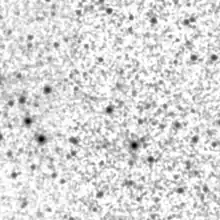HATS-36b
HATS-36 b is a gas giant exoplanet that orbits a F-type star. Its mass is 3.216 Jupiters, it takes 4.2 days to complete one orbit of its star, and is 0.05425 AU from it. It was discovered on June 12, 2017 and was announced in 2018.[3][4] Its discoverers were 23, namely Daniel Bayliss, Joel Hartman, George Zhou, Gaspar Á. Bakos, Andrew Vanderburg, J. Bento, L. Mancini, S. Ciceri, Rafael Brahm, Andres Jordán, N. Espinoza, M. Rabus, T. G. Tan, K. Penev, W. Bhatti, M. de Val-Borro, V. Suc, Z. Csubry, Th. Henning, P. Sarkis, J. Lázár, I. Papp, P. Sári.[5]
 An image of HATS-36 taken using the Kepler Space Telescope | |
| Discovery[1] | |
|---|---|
| Discovery date | June 12, 2017 |
| Transit | |
| Designations | |
| K2-145 b or EPIC 215969174b | |
| Orbital characteristics[2] | |
| 0.0529 (± 0.0011) AU | |
| Eccentricity | 0.105 ± 0.028 |
| 4.17524 (± 2.1×10−6) day | |
| Inclination | 87.57 (± 0.36)° |
| Physical characteristics | |
Mean radius | 1.235 ± 0.043 RJ |
| Mass | 2.79 ± 0.40 MJ |
Overview
The exoplanet HATS-36 b which orbits the star HATS-36 is located about 3186.5 light-years (977.0 pc) away from Solar System. It is situated in the constellation of Sagittarius. The host star HATS-36 has apparent magnitude of 14.4, with absolute magnitude of 4.4. The surface temperature is 5970 K with its spectral types of G0V class. In this planetary system, the extra-solar planet orbits around the star HATS-36 every 4.17524 days with its orbital distance of 0.05 AU (7913727.4 km).[4]
Discovery
After the discovery of the HATS-36 b, or its another alias name EPIC 215969174 b, it became one of the 25 HATSouth candidates on Campaign 7 of the K2 mission. It detects that the exoplanet, a hot Jupiter-like planet with a mass of 2.790.40 MJ and a radius of 1.2630.045 RJ, transits a solar-type G0V star (V = 14.386) in a 4.17524 days period. The planetary system of HATS-36 is classified as an eclipsing binary system based on a combination of the HATSouth data, the K2 data, and follow-up ground-based photometry and spectroscopy.[5][6]
Discussion
HATS-36 b has a typical orbital period of 4.1752379 ± 0.0000021 days and has a density of 2.12 ± 0.20 g/cm3. Its star is active, which can be seen and manifested in both the variability in the LC and the high jitters in the radial velocity measurements. Due to its high mass compared with the known population of hot Jupiters, HATS-36 b lies in a relatively sparsely populated region of the mass-density relationship for gas giant exoplanets. However, its bulk density fits well on the mass-density sequence of the related exoplanets.[5]
See also
- HATS-36
- List of potentially habitable exoplanets
- List of exoplanet firsts
- List of exoplanetary host stars
- List of exoplanets discovered using the Kepler spacecraft
- List of planets observed during Kepler's K2 mission
- List of nearest terrestrial exoplanet candidates
References
- Bayliss, D.; Hartman, J. D.; Zhou, G.; Bakos, G. Á.; Vanderburg, A.; Bento, J.; Mancini, L.; Ciceri, S.; Brahm, R.; Jordán, A.; Espinoza, N.; Rabus, M.; Tan, T. G.; Penev, K.; Bhatti, W.; de Val-Borro, M.; Suc, V.; Csubry, Z.; Henning, Th.; Sarkis, P.; Lázár, J.; Papp, I.; Sári, P. (2017). "HATS-36b and 24 other transiting/Eclipsing systems from the HATSouth - K2 Campaign 7 program". arXiv:1706.03858 [astro-ph.EP].
- http://exoplanet.eu/catalog/hats-36_b/
- "HATS-36 b | New World Atlas - Exoplanet Exploration: Planets Beyond our Solar System". Exoplanet Exploration: Planets Beyond our Solar System. Retrieved 2018-07-05.
- "HAT-36 b". www.exoplanetkyoto.org. Retrieved 2018-07-05.
- Bayliss, D.; Hartman, J. D.; Zhou, G.; Bakos, G. Á; Vanderburg, A.; Bento, J.; Mancini, L.; Ciceri, S.; Brahm, R. (2017-06-12). "HATS-36b and 24 other transiting/eclipsing systems from the HATSouth - K2 Campaign 7 program". arXiv:1706.03858 [astro-ph.EP].
- Bayliss, D.; Hartman, J. D.; Zhou, G.; Bakos, G. Á; Vanderburg, A.; Bento, J.; Mancini, L.; Ciceri, S.; Brahm, R. (2018). "HATS-36b and 24 Other Transiting/Eclipsing Systems from the HATSouth-K2 Campaign 7 Program". The Astronomical Journal. 155 (3): 119. arXiv:1706.03858. Bibcode:2018AJ....155..119B. doi:10.3847/1538-3881/aaa8e6. ISSN 1538-3881.


